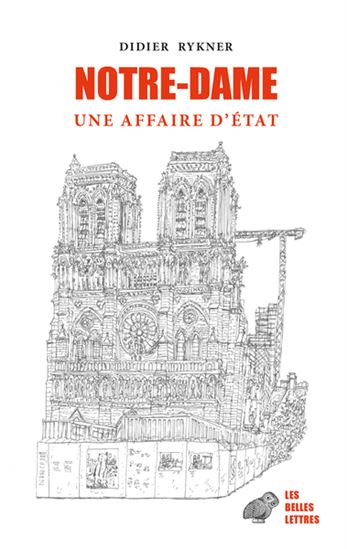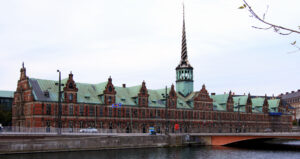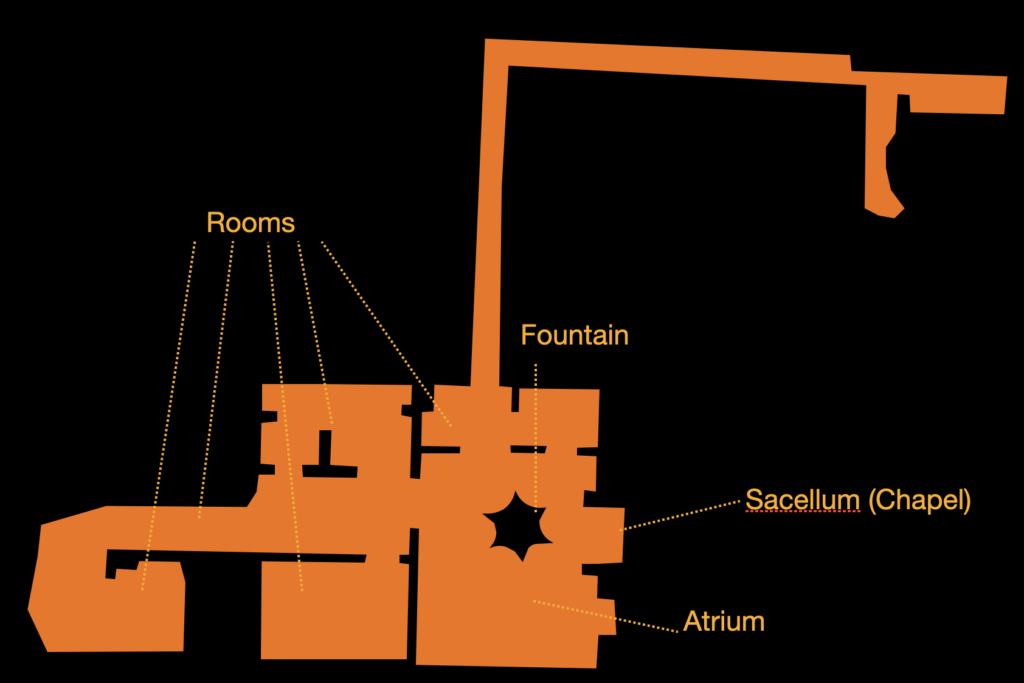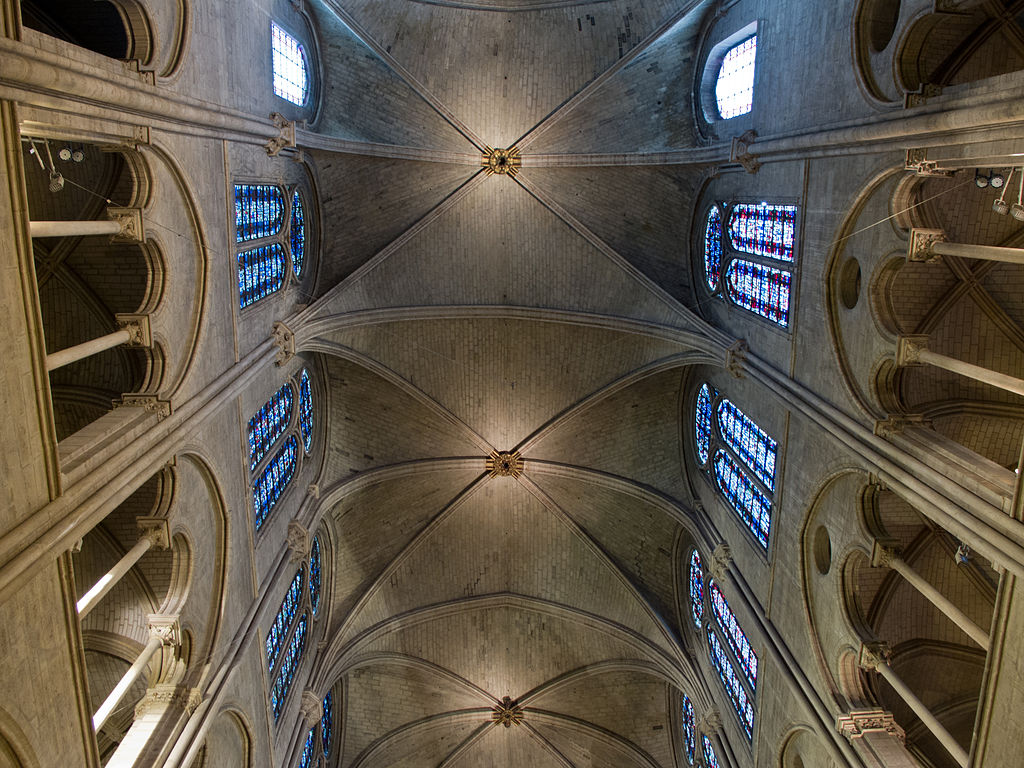Notre Dame Fire: What we Know About
The 15 April 2019 Notre Dame Cathedral fire is an iconic event and deserves to be studied appropriately. In the following text will be presented some considerations based on the information available on the internet.
Following at least 30 years of tragic fires that have destroyed several important cultural resources all over the world, such an important renovation site should have been followed with the utmost care. That does not mean that fire could not start but that a different outcome could have been reasonably expected if a fire happened. So, in order to better understand what really happened and, more important, why it happened (the site does not have access to direct information), in the following sections, articles and posts containing information and news about the fire will be quoted, together with the available information about the context, and the fire extinguishing operations carried out by the Paris Fire Brigade.
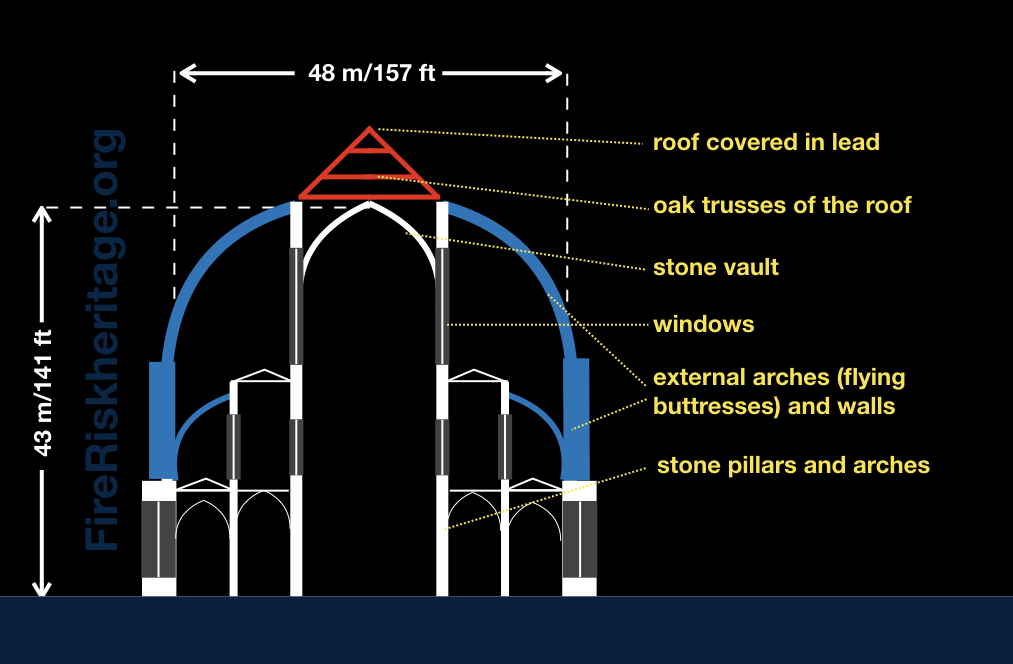
The Structure
The construction scheme of the building (fig. 1) has a relevant part of what has happened during the fire. Like most of the gothic cathedrals, the slender stone structure is covered by a wooden (oak) structure. As widely known by firefighters, a fire that occurs in a wood poses serious problems during extinguishing operations, both to their safety and to the building integrity. In simple terms, the problem is related to the impossibility of fighting the flames throwing water from above, since one of the main functions of a roof is avoiding that water gets inside the building. That implies that a roof fire should be fought from the inside.
In the cathedral fire, the stone vault below the wooden roof would have prevented to extinguish the fire from the ground level, even if adequate appliances capable of pumping water to 43 m/141 ft would have been available in the early phases of the fire. But normally, as happened in Notre Dame fire, the roof structure is not designed to let smoke and heat flowing outside, keeping temperature and visibility within a certain range that allows first responders to do their job in relatively safe conditions. On the contrary, the limited volume, in case of fire, makes temperature grow fastly, compromising also the stability of the structural elements. This is the condition that has been described for the 15th April 2019 fire, with one more specific problem. According to the website of the Paris Fire Brigade, the vehicles available to the Brigade that can be used in this kind operation can reach at most 32 m /104 ft with a remarkable 3.000 l/min water flow rate. Since the roof is located at more than 40 m /131 ft above the ground level, it’s reasonable to think that the operations were not easy for the firefighters (fig. 2) working from the outside, while the operations form the inside must have been dangerous (because of the high temperatures, the smoke and the risk of structural collapse) and extremely challenging, due to the need of climbing to the roof level carrying the needed equipments.
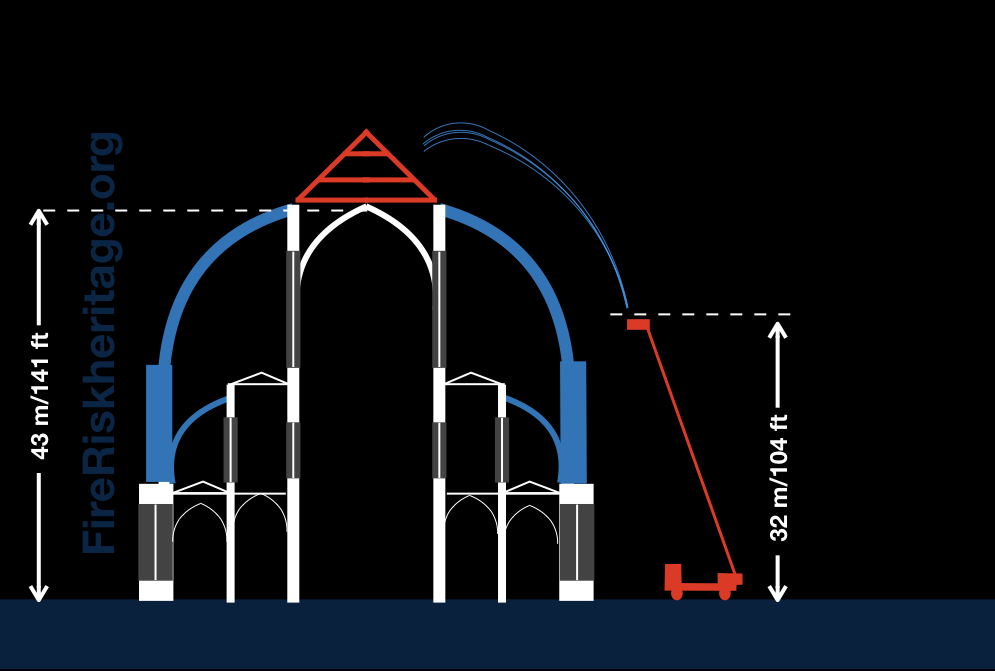
Damages and saved artifacts
In order to describe the damages suffered by the Cathedral, some information about the importance of every single element on the overall static behavior of the building must be described. In particular, as in every vaulted space, we know that the horizontal thrust of an arch or a vault has to be balanced by a corresponding thrust or by an adequate mass. These masses or thrusts serve to make the lateral components of the thrust horizontal, preventing the structures to which the arches and ribs rest are overturned (Fig. 3).
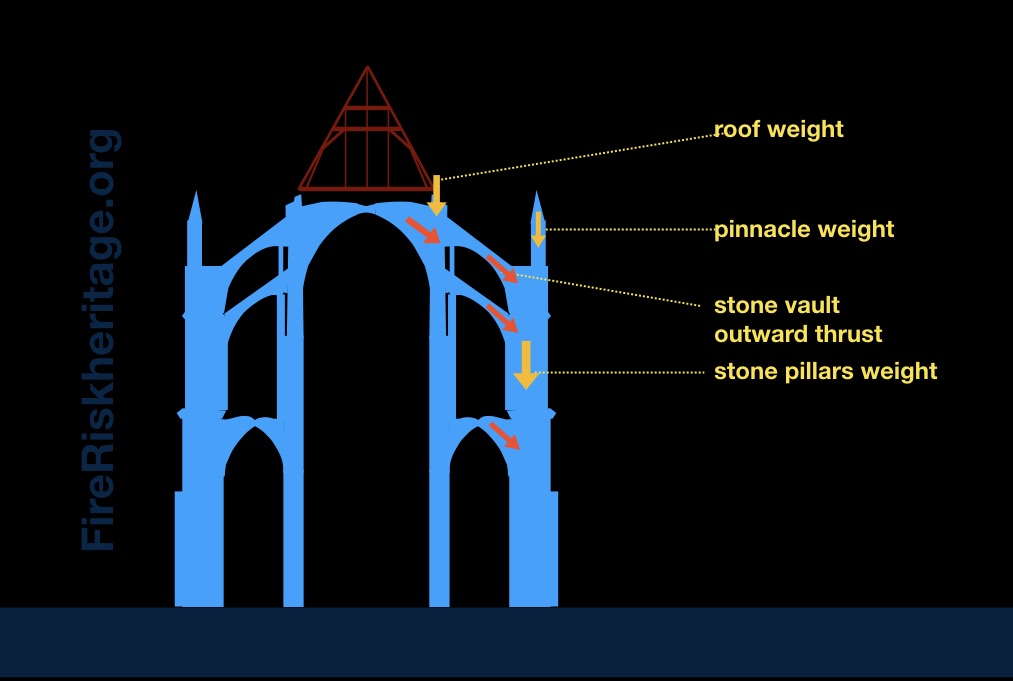
In Gothic cathedrals, this need is particularly felt due to the extremely daring project. The arches and ribs of the vaults, in fact, are very thin and concentrate their thrust on limited surfaces. So, wooden roofs and pinnacles have an important static function together with their first intended use of protecting from rain (roofs) and adding an aesthetic element to the building. In the case of Notre Dame, the destruction of the wooden roof, that was protected by some 200 metric tons of lead, may pose an important threat to the stability of the building.
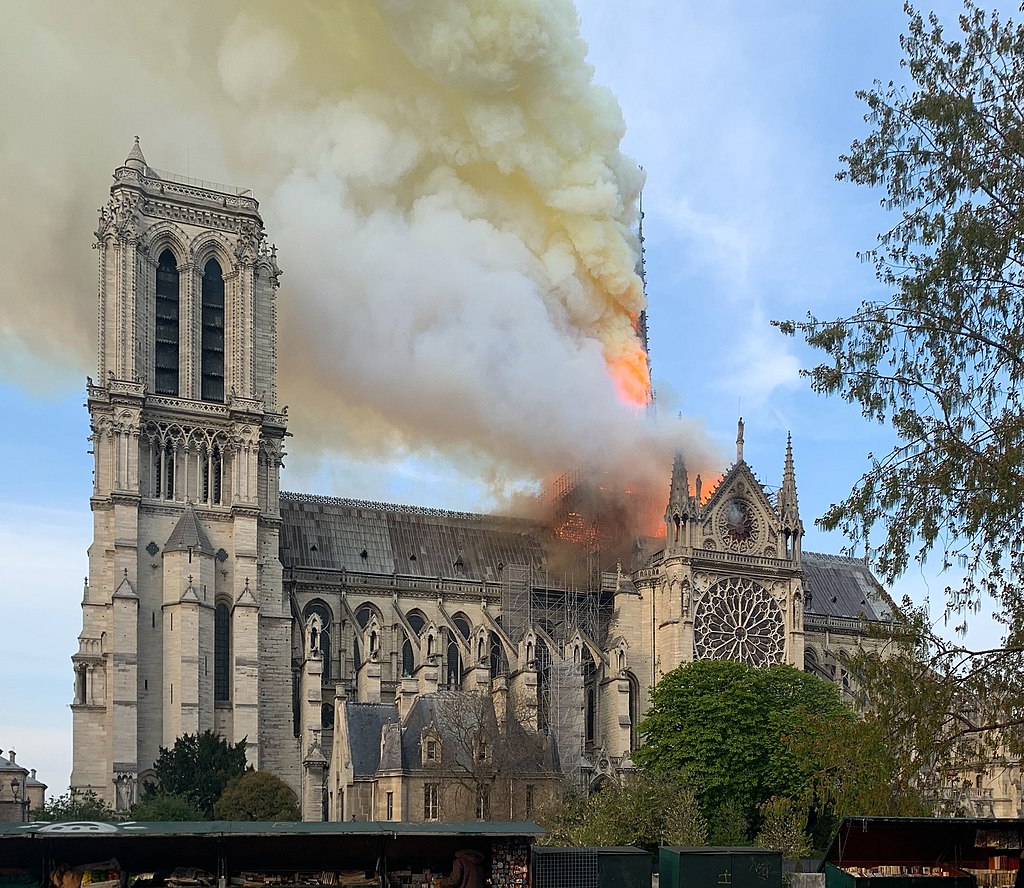
The second extensive damage that the fire caused to the cathedral, which must be mentioned due to the profound effect on the stability of the building, is the degradation caused by the high temperatures developed within the building during the blaze to the mechanical characteristics of the limestone elements, which compose pillars, walls, arches and buttresses of the building.
Pillars, arches, and walls that must support the weight of the structures above and the horizontal forces that the complex static system generates could be much weaker than is necessary. In order to understand the effect of
In the case of the the Gran Teatro
In order to figure out the vastity of the work that is waiting to be carried out to recover Notre Dame cathedral, after the fire that damaged in 1997 severely the much smaller baroque Cappella Guariniana (also known as Cappella
Returning to the fire of Notre Dame, among the other damages we must consider the nineteenth-century pinnacle called “the Spire”, the historic timber (perhaps the centuries old) of the so-called forest (inner structure of the roof), part of the vault in the central section, windows, and some artifacts kept within the cathedral.
The fire was primarily attributed to an accident and has been linked to the renovation work being conducted on the cathedral but years after the event its cause is not still known.
Particularly accurate studies and articles have been published on the causes of the fire, such as those in the New York Times (https://www.nytimes.com/interactive/2019/04/15/world/europe/paris-notre-dame- fire.html), https://www.nytimes.com/2019/04/19/world/europe/notre-dame-fire-safety.html
https://www.nytimes.com/2019/07/17/world/europe/notre-dame-cathedral-fire.html or the Smithsonian Institute: https://www.smithsonianmag.com/smart-news/five-things-weve-learned-aftermath-notre-dame-fire-180971998/, and all the documents and articles available converge towards a cause which, even if considered certainly accidental, is not better identifiable.
In the 2023 book «Notre-Dame une affaire d’Etat» Didier Rykne, Art historian, journalist and founder of the website La Tribune de l’art, has published his investigation into the Notre-Dame fire, denouncing the fact that adequate efforts had not been made to clarify the cause of the fire and that the documents which highlighted the reduced level of safety in the event of fire of the Basilica, like many other historic buildings of a religious nature in France, have been neglected.
The Rykner’s Report is an analysis of all the events that led to the accidental fire of Notre-Dame in April 2019 in which the author questions the real causes of the disaster, in particular the renovation site, which remains a factor in the event that it it was not the only cause. The report also discusses the controversies and lessons that the Ministry of Culture was able to draw from them to avoid a similar accidents.
Reconstruction Works
The reconstruction works, updated at 2023 are detailed in the Friend of Notre Dame website.
The Re-opening
According to the Parisjetaime website, Notre-Dame Cathedral will be reopened on December 8, 2024. A special thanksgiving celebration (Te Deum) will be held on April 15, 2024, 5 years after the fire.
